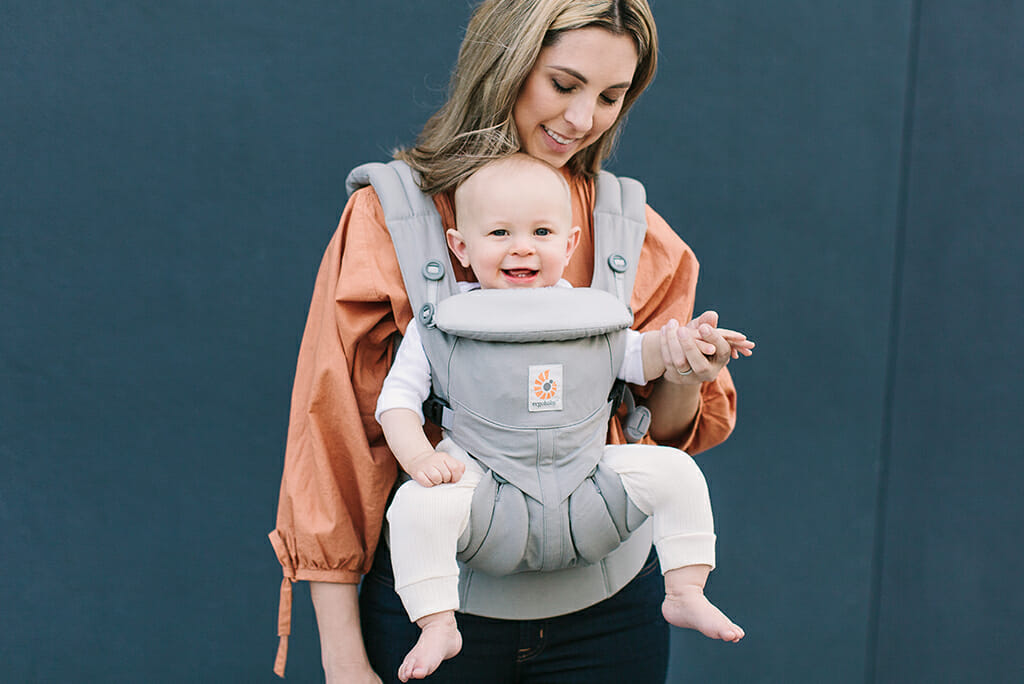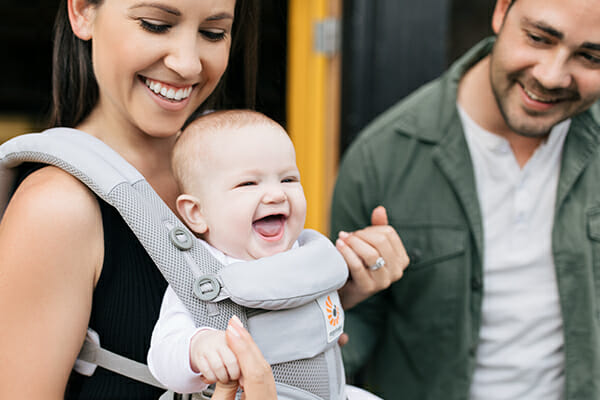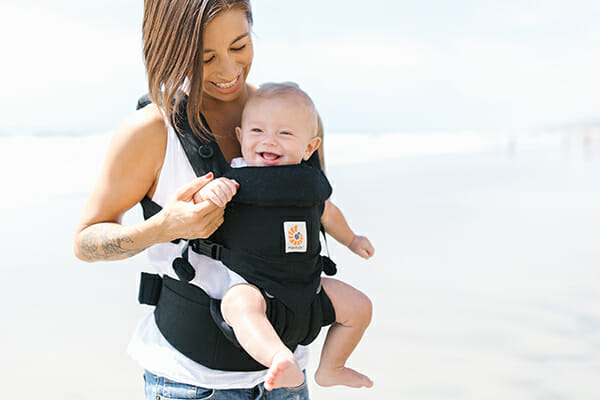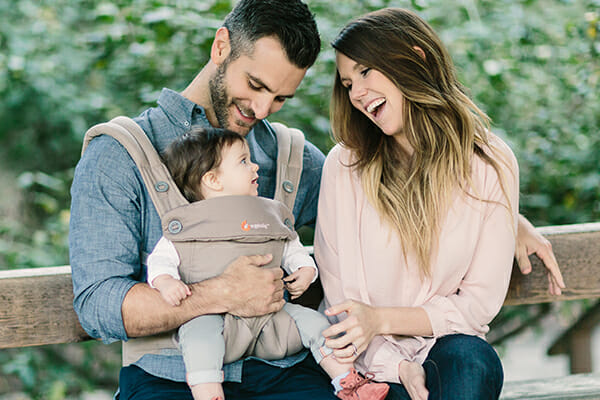
When shopping for a baby carrier, wearing baby in a front outward facing position is a feature that a lot of parents look for. Although some babies do not enjoy being carried facing outward, many love being able to watch the world around them, exploring new sights and sounds with the comfort of you close behind.
Unlike sitting facing the world in a stroller, wearing your baby front outward facing means she is held up higher where she can see over the fence at the farm for you to point out the animals or up at conversational height on a woodland walk, able to reach out and touch the leaves.
Before you embark on your world-facing adventure, you should know the signs that mean your child is ready, how to wear baby in an optimal, front outward facing position in our 360 or Omni 360 carrier and when baby needs to be turned back to a parent-facing position.
Signs Baby is Ready to Try Front Outward Facing
As baby’s brain develops and their muscles strengthen, they may begin showing you signs that they want to face the world. It is important to remember there is no rush and inward facing can still offer an outward view for your child.
Once your baby can see above the front panel of the carrier when sitting in the carrier, has strong head & neck control, and has a natural curiosity to see and interact with the world, they are ready for front-outward carry. We recommend starting with short durations (5-10 minutes) to prevent over-stimulation. If baby shows signs of over-stimulation (zoned out, catatonic, fussy, tired) or sleepiness, just turn them back around to front-inward, so they can find comfort in their wearer and rest.
Optimal Front Outward Facing Positioning in Ergobaby 360 and Omni 360
When outward facing in our Omni 360 Carrier or 360 Carrier, the seat buttons should be changed from black to grey. These should be changed back to black when changing baby back to an inward facing carry position.
When outward facing in our Omni 360 Cool Air Mesh Carrier, the sliders should be pushed down to the lowest possible position. The sliders should be pulled back to the top when changing baby back to an inward facing carry position.
When NOT to Wear Baby Outward Facing
Baby still requires the infant insert in our All Position 360 carrier.
Using the infant insert suggests that baby is under 4 months old and would not be developmentally ready to face outwards. If baby is over 4 months, but still needs the insert as he is on the small side, he may not be able to sit comfortably with his chin above the main panel of the carrier if facing outward. This means baby is not ready for front outward facing.
Baby is under 5 months old and/or does not have strong and consistent head and neck control.
Baby’s airway can become compromised if they do not have the strength to hold up their head steadily for a prolonged period of time. Usually, baby will have this strength at around 5-6 months.
You are wearing baby in our Original or Adapt Baby Carrier.
These carriers are not designed to hold baby ergonomically in the front outward facing carry position.
You have been wearing baby facing outward for more than 20-30 minutes.
Babies can easily become overstimulated and overwhelmed, so while in the front outward facing position, if your baby becomes agitated or fussy, we recommend switching back to facing inwards or to try the back or hip positions (if baby is over 6 months).
Baby is sleeping.
There is no front outward facing carry position that is safe for baby to sleep in.
If baby falls asleep in the front outward facing position, it is important to switch to an inward facing carry position, where baby’s head is supported against your body. This should stop baby’s chin from touching her chest and compromising her airway.
Baby is showing signs of overstimulation (zoned out, catatonic, fussy, tired).
In new, busy or crowded environments, it is easy for baby to become overstimulated. Their brains have not yet developed the skill of being able to filter out unnecessary information about their surroundings.
Signs of overstimulation are :
• Appearing zoned out
• Catatonic
• Fussy
• Tired
Front Outward Facing Carrying Tips
• Follow your baby’s lead as to when it’s time to be done facing out. Situations that are unfamiliar or crowded are going to be more stimulating than an environment your baby is accustomed to.
• Hold your baby’s hands, touch her feet, and talk with her reassuringly if you’re both new to facing out.
• To make sure baby’s legs are supported and hips are in an optimal position, use the pelvic tuck. Watch how here.
• Consider a hip carry as an alternative. Your baby can see, but can also rest her head when she gets tired or overstimulated.
• Stop if it’s uncomfortable for you, or if your baby seems uncomfortable. Seek help from a sling library or babywearing consultant to see if adjustments can be made.
Summary
Our Ergobaby baby carriers are all ergonomic, including our 360 and Omni 360 models which offer an ergonomic, front outward facing position. These carriers were developed in response to parents’ requests for an ergonomic fourth position option for babies over 5 months.
These carriers have been developed with input from parents, midwives, babywearing educators and our design team, all focused on ergonomics.
Our message is simple: follow your baby’s lead and respond to her cues. We acknowledge that parents know their babies best, so choose the position and carrier that works for you and your family 💗
We love seeing you out exploring with your little ones.
Be sure to tag us in your pics on social media!
| Facebook |
Instagram |
YouTube |

credit (from top left) : @rachelledanser/@m2mdigital, @babylilyadventures, @hannahstammas, @thewaltonadventure, @gingerandbluphoto, @roxifbabyyy, @thechelliahlife, @heyitsromeca, @themamaedituk
Related Links :
The Fuss About Facing Out | Sheffield Sling Surgery
Facing in? Facing Out? A Science-Based View on Baby Carrying Positions | Ergobaby US
The T.I.C.K.S Rule for Safe Babywearing | Ergobaby UK
Checking Baby’s Position in an Ergobaby Carrier | Ergobaby UK
A Pediatric Orthopedic Surgeon and Dad on Babywearing | Ergobaby UK






